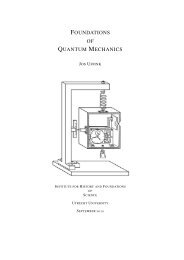Simple analytical models of glacier-climate interactions - by Prof. J ...
Simple analytical models of glacier-climate interactions - by Prof. J ...
Simple analytical models of glacier-climate interactions - by Prof. J ...
Create successful ePaper yourself
Turn your PDF publications into a flip-book with our unique Google optimized e-Paper software.
Fig. 7.2<br />
3500<br />
3000<br />
2500<br />
h (m)<br />
2000<br />
1500<br />
1000<br />
500<br />
perfectly plastic<br />
plane shear 1<br />
plane shear 2<br />
0<br />
0 200 400 600 800 1000 1200 1400 1600<br />
r (km)<br />
A few interesting conclusions can be draw from the plane-shear solution. For n=3 eq.<br />
(7.10) reads<br />
H 0 = 2<br />
1/8<br />
b<br />
2 A*<br />
R 1/2 (7.13)<br />
This shows that the dependence <strong>of</strong> the ice thickness on the accumulation rate is quite<br />
weak. Halving the accumulation rate reduces the ice thickness <strong>by</strong> only 8%. The same<br />
applies to the relation between ice thickness and flow parameter. On the other hand, the<br />
dependence on ice-sheet radius is larger. Halving the radius reduces the ice thickness <strong>by</strong><br />
30%.<br />
It is hard to judge which model performs best. It is clear that the perfectly plastic model<br />
is not very accurate in the central part <strong>of</strong> an ice sheet. However, in many applications this<br />
does not matter at all. One can try to check the validity <strong>of</strong> the pr<strong>of</strong>iles <strong>by</strong> comparison with<br />
observations. This does not give definite answers as to which pr<strong>of</strong>ile performs best (Van<br />
der Veen, 1999). The less steep slope <strong>of</strong> the parabolic pr<strong>of</strong>ile closer to the ice edge seems<br />
more realistic in many cases, albeit for the wrong reason (in reality s<strong>of</strong>ter ice and sliding<br />
over deformable beds leads to reduced ice thickness).<br />
It is noteworthy that the dependence <strong>of</strong> ice thickness on the radius is the same for the<br />
plane-shear and perfectly-plastic <strong>models</strong>. Altogether, when interest is in the large-scale<br />
response <strong>of</strong> ice sheets to environmental change, and when changes in ice volume are<br />
expected to be mainly the result <strong>of</strong> changes in R, then the perfectly plastic model is not a<br />
bad choice.<br />
25
















